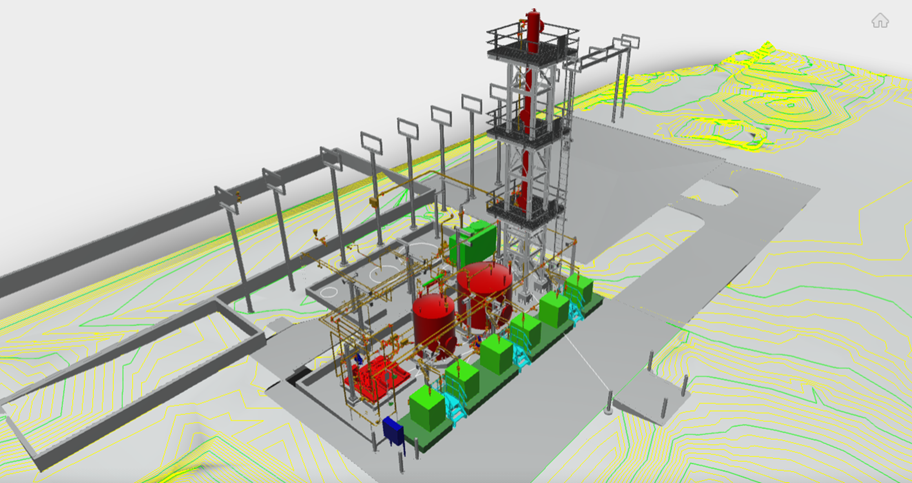A Midwest client tasked Brindley Engineering to develop multi-discipline design drawings for the expansion of process boundaries. New mechanical equipment was being installed to increase the facility production capabilities that required civil/structural and instrumentation control contribution.
Process Vent Scrubber
Mechanical Design
The Brindley Engineering mechanical team was tasked with the equipment layout, nozzle orientation and piping design for a new air scrubbing system. The existing storage and air scrubbing system had reached their retirement age. New environmental regulations are anticipated to require the new scrubbing system to reduce venting to atmosphere from 99% to 99.9%. Field walk downs and 3D scans were completed to determine the proper tie-points into the existing air scrubber system. The scrubbing system uses PTFE lined carbon steel piping as the process piping. The process and equipment design were completed by the Client.
The mechanical team coordinated the process unit layout optimizing operation, maintenance, and economic efficiency while working with the structural team to provide support and accessibility to the area. The mechanical design also involved multiple metallurgies, including lined components and polymer tanks, creating unique engineering and constructability challenges.
Due to fluid characteristics, process piping required a liner that was installed during offsite spooling of the pipe components. Should any field modifications be required, this liner would complicate onsite adjustments and potential installation delays, so it had to be perfect.
To facilitate the tight tolerances, a 3D scan provided the benchmark to develop deliverables with precision.
Our Challenges
This project was on an accelerated schedule due to complications involving COVID-19. The Brindley Engineering team had to work efficiently and communicate effectively (during the process of shifting to remote work only) to get this project executed on time. The design also required that the existing air scrubber system remain operational while the new system was installed allowing for minimal down time to switch over to the new system.
The client’s piping specification for the process system required the pipe, fittings, valves, and specialty items to be PTFE lined carbon steel and of flanged construction. The design also required the use of totes and loading arm assemblies that needed to be accessible to both the operators switching between totes and for a fork truck to be able to access the totes. The project was executed using AutoCAD Plant 3D and although the software package comes loaded with several pre-existing piping specs, flanged PTFE lined piping was not included. The Brindley Engineering piping design team was able to locate electronic pipe and basic component libraries that had been created directly by the fabricator and used them to aid in building the required client piping specification, saving the project money. Certain valves and specialty items such as flanged flex hoses were also needed and had to be custom built by the design team. Additionally, the very nature of the process piping system required flange sets to be located every 20’-0”. The Plant 3D spec was created such that the flange sets would be placed automatically at this distance during modeling, thus reducing the overall design time. One final challenge was that this type of piping also required specific gasket sets and odd bolt lengths when connecting to flat-faced flanged equipment, which the software would not allow.
BE the Result
Through teamwork and good communication, the piping design team ensured that the proper materials and dimensions ended up on the isometric deliverables. The project was a great success, being brought in on-time and on-budget and without any field revisions. We are especially proud of this considering all the technical complexities, the tight timeframe, and COVID disruptions that had to be overcome to bring this project in with such great success.


0 Comments